Be It Known: Women’s Wills Mirroring Anglo-Saxon Times
Anglo-Saxon England was a wealthy world with a gold and silver coinage from the early 600s, beginning in Kent and East Anglia. It had been pagan in the 400s but by the ninth and tenth century it was fervently Christian with a highly sophisticated, international trading system importing fine wine as well as expensive silks from the East destined for the richest folk. However, in stark contrast it could also be an extremely violent, brutal, turbulent world with raiding, fighting and battles not least due to the constant invasions and settlements by the Norse Vikings. At Repton – the Vikings’ winter camp in 873/4 – in the north of England there is a mass grave where at least 264 bodies were buried.
Yet despite or perhaps because of the raids and the wars, strong bonds of family and kinship were forged, as is evidenced in the wills of the women of these times. In their wills, these women weave the golden threads between their ancestors and descendants. Among the earliest wills, one testifies to the strong bond and love between a grandmother and her grandchildren. It has been ever thus through every century into modern times and no doubt will be true hereafter. The same is found in so many other cultures as there is something very precious embedded in the hopes for grandchildren, the younger, future generations of any family.

Detail of a miniature of Gaia Caecilia or Tanaquil at her loom, while women spin and card wool. British Library (Public Domain)
Spinning, Weaving and Brewing
The items mentioned in the wills include household goods and furnishings such as tapestries; much of which would have been produced by the women of the household. Professor Gale Owen-Crocker, an expert on all matters to do with Anglo-Saxon clothing, believed most women could probably weave. Every grand estate or farmstead usually had its own weaving and spinning industry which was essential in order to produce clothes, bed linen and wall hangings. One woman’s role in the production of cloth was as a spinster – someone who would spin the threads and yarn which eventually became the woven cloth of wool (from sheep and goats) or linen from flax. It is the “ster” in spinster, seamster and webster (a female weaver) which denote these as women’s jobs. Women in the lower social classes might have been bakers, dairy maids, cheesemakers and brewers who were also known as brewsters.
Like this Preview and want to read on? You can! JOIN US THERE ( with easy, instant access ) and see what you’re missing!! All Premium articles are available in full, with immediate access.
For the price of a cup of coffee, you get this and all the other great benefits at Ancient Origins Premium. And - each time you support AO Premium, you support independent thought and writing.
Viki Holton is a Research Fellow (Adjunct) at Ashridge Executive Education, Hult International Business School. Her earlier interests in women in business and leadership has developed recently to include a book about women’s social history, a 1,000 years of women’s wills: A Woman’s Will: The Changing Lives of British Women told through the Things they have left Behind by Amberley Publishing.
Top Image: Sir Geoffrey Luttrell and his wife, Agnes Sutton entertaining. On the table are knives, spoons, dishes, and plates or trenchers of bread. (CC0)
By: Viki Holton
















